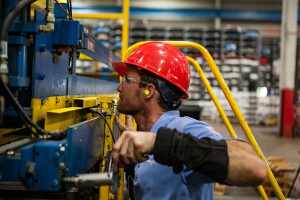The market for industrial robot installations has been on a skyward trend since 2009, and it is not expected to slow down any time soon. According to the World Robotics 2015 report, the market for industrial robots was approximated at $32 billion in 2014, and in the coming years it is expected to continue to grow at a compound annual growth rate (CAGR) of at least 15%.
That means between 2015 and 2018, it’s anticipated that 1.3 million industrial robots will be installed worldwide. This will bring the stock of operational robots up to just over 2.3 million, mostly working in the automotive and electronics sectors.
For how long can the global robot population continue to grow?
Robot Density
Perhaps the most interesting way to peek into the future of industrial robot installations is to look at potential sales in China.
Currently, the world’s most populous nation has a density of robots that is about half of the world average, equal to just 36 robots for every 10,000 manufacturing workers in China.
However, this is changing fast. It’s been the largest market for robots since 2013, and in 2014 the country bought 57,100 robots – the highest quantity ever recorded in a year. By 2018, one in every three robots in operation around the world will be in China.
What will happen if China’s density approaches that of other robot industrial centers?
Highly automated countries such as Germany, Japan, and South Korea all have robot densities that are multiples higher. South Korea, for example, has 478 industrial robots for every 10,000 workers – a ratio that is 13x higher than China’s.
With this kind of potential for growth, it’s clear that this is only the start of the robot story.
 I have already criticized the March jobs report released by the Bureau of Labor and Statistics. The mainstream media is cheering the 303,000 position boost as proof that the American economy is on the right path. I noted in an earlier blog post that the number of part-time workers rose by 691,000 while the number of full-time workers decreased by 6,000. The Bureau of Labor and Statistics admitted that the number of Americans holding multiple jobs increased by 217,000 or 5.2%, as Americans cannot afford the current cost of living even with wages rising 4.1% YoY.
I have already criticized the March jobs report released by the Bureau of Labor and Statistics. The mainstream media is cheering the 303,000 position boost as proof that the American economy is on the right path. I noted in an earlier blog post that the number of part-time workers rose by 691,000 while the number of full-time workers decreased by 6,000. The Bureau of Labor and Statistics admitted that the number of Americans holding multiple jobs increased by 217,000 or 5.2%, as Americans cannot afford the current cost of living even with wages rising 4.1% YoY.



 Robots are not to blame for the loss of millions of U.S. manufacturing jobs.
Robots are not to blame for the loss of millions of U.S. manufacturing jobs.



